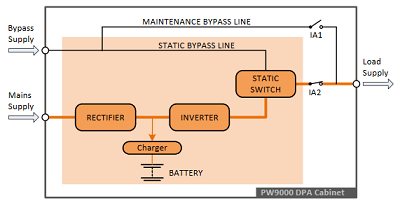Data centre and ICT system operators invest in UPS power protection equipment to avoid the serious financial and reputational consequences of a power anomaly or outage. However, for this strategy to be successful, the UPS system itself must be maintained in good health and ready to protect its critical load whenever the need arises.
In this article, Mike Elms, Technical Manager at KOHLER Uninterruptible Power Ltd., a KOHLER company, shows how setting up a tailored remote monitoring and on-site maintenance package with a specialist UPS supplier can be the most cost-effective solution as well as the best way of eliminating the risk of a power outage.
Owners of data centres and most other ICT systems invest in UPS power protection to avoid the serious financial and reputational consequences of a system outage. Lost wages and salaries that must be paid to staff while they are prevented from working, and lost revenues as transactions become impossible to complete, are just the start. There are also the consequential costs of remediation and repairs, extra overtime, and possibly the obligation to pay damages or penalties to third parties for breaching service agreements.
With these cost factors in mind, it’s easy to see how a few hours’ downtime could rapidly generate a bill for tens of thousands of pounds. It’s also easy to justify the investment in UPS equipment to prevent this ever happening. However, the UPS itself must be protected from harm or failure, to ensure it always responds when power emergencies occur.
As for any electrical or electronic equipment, UPS health can be assured if it is monitored and maintained regularly – but only if these activities are performed to rigorous professional standards. 50-80% of all unplanned outages are caused by in-house staff. Problems usually arise because personnel have been given responsibilities outside their area of expertise.
Accordingly it makes more sense to entrust emergency system care to specialists. KUP, offers separate packages for remote monitoring of UPSs, batteries and generators, as well as options for onsite emergency and scheduled maintenance. By choosing from these packages and tailoring them to the specific needs of their own site, customers can negotiate a solution that may well be no more expensive than training internal staff, while vastly reducing the chance of a UPS system failure.
Monitoring for batteries, UPSs and generators
KUP’s flexible solution comprises three separate monitoring packages: PowerNSURE, PowerREPORTER UPS and HawkEye2 Generator. These can be complemented by onsite maintenance agreements at appropriate service levels.
PowerNSURE is an advanced battery monitoring product, employing battery-top sensors that can be accessed over a local network and via the Web. The sensors continuously measure the internal resistance, voltage and temperature of every single battery cell. Battery resistance values are important, because they can warn of developing problems within the cells.
Many problems are caused by poor equalisation, in which some battery cells receive an excessive charging voltage while others do not receive enough. Using voltage measurement feedback, PowerNSURE runs an equalisation process to prevent this happening. As a result, battery life is prolonged, while early action can be taken if any resistance values become abnormal.
Battery temperatures are monitored as excessive heat can cause failures, while low temperatures can negatively impact battery performance.
PowerREPORTER provides a 24/7/365 Internet-based remote monitoring service for UPSs, detecting any error or alarm messages. Software automatically warns KUP’s service centre network of any incident via email, providing all available details relating to the fault.
A field service team responds by interrogating and managing the UPS, and performing any necessary diagnostics. A technician then visits the site within the contracted agreement timeframe, equipped with any necessary spare parts.
Generators can be managed 24/7/365 using KUP’s Hawkeye2 remote monitoring. Hawkeye2 automatically starts a customer’s generator system once a week, checking vital operating parameters. A full condition report is then sent to a monitoring centre via phone line or GSM upload. SMS or voicemail reports can also be sent to nominated numbers.
Continuous monitoring of generator conditions, with alarm generation, is performed during emergency operation.
On-site maintenance
Monitoring, while essential in gaining visibility of UPS status, must be complemented by on-site maintenance contracts to round out an effective UPS care strategy. Service levels should be agreed to guarantee response times appropriate to the critical load’s needs. Regular checking of battery physical conditions, along with periodic load bank testing is particularly important, but other UPS factors should be regularly checked as well. These should check correct operation of instrumentation and indicators, switchgear, airflow, air-filter changes, cleanliness and freedom from debris, secure connections, absence of corrosion or damage, and that the UPS is running smoothly.
Follow us on LinkedIn for regular industry articles & company information





